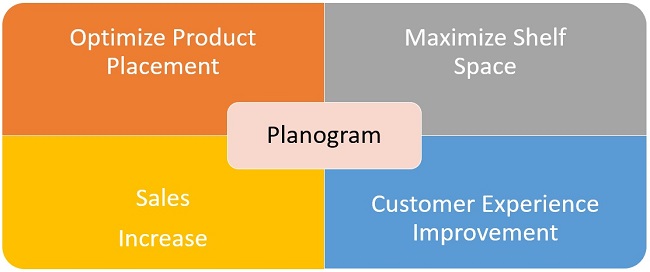- Business Concepts ›
- Marketing and Strategy ›
- Planogram
Planogram
Definition, Importance, Types & Example
This article covers meaning & overview of Planogram from marketing perspective.
What is meant by Planogram?
Planogram is a graphical representation of how merchandise or products should be arranged on shelves or displays in a retail outlet or a store. It is a detailed blueprint that provides retailers an overview on where to place products, how much shelf space to occupy, and how to organize products to maximize sales, customer attention and satisfaction.
Planograms can be created using specialized software that takes into account a variety of factors, including size, shape, color, form factor, sales history, and demand. By using a planogram, retail stores can create an organized display that is easy for customers to navigate and go through while helping in increase of sales and stock optimization.
Planograms are commonly used in retail settings, such as grocery stores, mobile/technology stores and department stores but can be applied to any type of business where products are displayed on shelves or racks.
Importance of Planograms
Planograms are important for the retail sector because of the following reasons:
1. Optimize Product Placement
Planograms help retailers optimize product placement by organizing products in a logical and visually appealing way. This can help customers find what they're looking for more easily, which can lead to increased sales.
2. Maximize Shelf Space
Planograms help retailers maximize their use of shelf space by ensuring that each product is given the right amount of space. This can help reduce overstocking and out-of-stocks, which can result in lost sales.
3. Increase Sales & Improve Customer Experience
By optimizing product placement and maximizing shelf space, planograms can help retailers increase sales.
This is because customers are more likely to purchase products that are easy to find and that are presented in an accessible way to navigate the store. This also improves the customer experience.

Types of Planograms
Here are a few types of planograms you might come across:
1. Floor plan planograms
Floor plan planograms show the overall layout of a store or section and how products should be placed on the floor.
2. Wall planograms
Wall planograms show how products should be arranged on a wall such as a e.g. Tools or hardware.
3. Pegboard planograms
Pegboard show how products should be hung on a pegboard such as a display of toys or art supplies.
4. Shelf planograms
Shelf show how products should be arranged on a shelf e.g. as a display of cosmetics or snacks.
5. Endcap
Endcap show how products should be arranged on an endcap which is a display at the end of an aisle.
Planogram Example
Let us take an example of ABC Retail store which sells fruits, vegetables, dairy products, meat, and frozen foods. A planogram for ABC Retail would include the following elements:
The planogram would start with a floor plan which would show the layout of the different sections.
Each section with its own planogram would be showing how products should be arranged on the shelves or displays. The other planograms can be Fruits and Vegetables, Dairy, meat and frozen foods section. Each of these sections would have its own style of layouts to promote sales and ease customer navigation and visibility.
Hence, this concludes the definition of Planogram along with its overview.
This article has been researched & authored by the Business Concepts Team which comprises of MBA students, management professionals, and industry experts. It has been reviewed & published by the MBA Skool Team. The content on MBA Skool has been created for educational & academic purpose only.
Browse the definition and meaning of more similar terms. The Management Dictionary covers over 1800 business concepts from 5 categories.
Continue Reading:
What is MBA Skool?About Us
MBA Skool is a Knowledge Resource for Management Students, Aspirants & Professionals.
Business Courses
Quizzes & Skills
Quizzes test your expertise in business and Skill tests evaluate your management traits
Related Content
All Business Sections
Write for Us